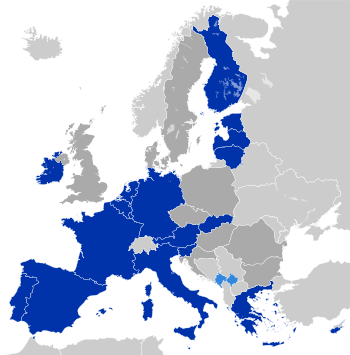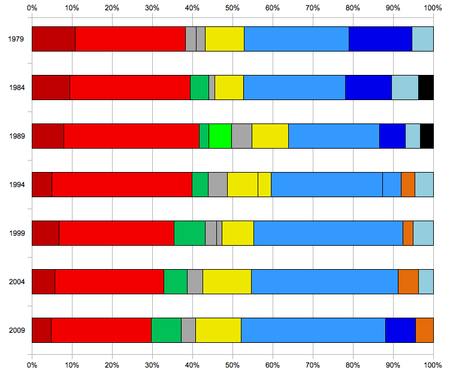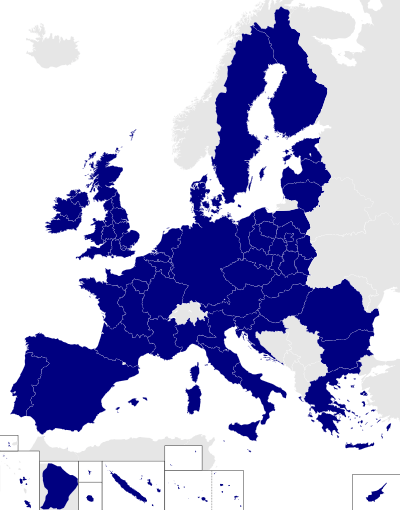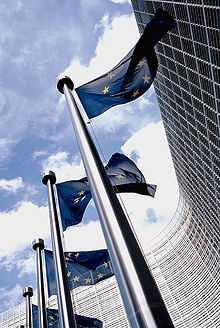European Development Fund
| European Union |
 This article is part of a series on the |
Policies and issues
|
Elections
|
The European Development Fund (EDF) is the main instrument for European Union (EU) aid for development cooperation in Africa, the Caribbean, and Pacific (ACP Group) countries and the Overseas Countries and Territories (OCT). Funding is provided by voluntary donations by EU member states.[1] The EDF is subject to its own financial rules and procedures, and is managed by the European Commission (EC) and the European Investment Bank.[2]
Articles 131 and 136 of the 1957 Treaty of Rome provided for its creation with a view to granting technical and financial assistance to African countries that were still colonised at that time and with which certain countries had historical links.
Usually lasting 6 years, each EDF lays out EU assistance to both individual countries and regions as a whole. The EU is on its 10th EDF from 2008-2013 with a budget of €22.7 billion.[1] This represents about 30% of EU spending on development cooperation aid, with the remainder coming directly from the EU budget.[1]
The budget of the 10th EDF can be broken down as follows:[3]
- €21 966 million to the ACP countries (97% of the total),
- €17 766 million to the national and regional indicative programmes (81% of the ACP total),
- €2 700 million to intra-ACP and intra-regional cooperation (12% of the ACP total),
- €1 500 million to Investment Facilities (7% of the ACP total).
- €286 million to the OCTs (1% of the total),
- €430 million to the Commission as support expenditure for programming and implementation of the EDF (2% of the total).
Negotiations are ongoing for the 11th EDF, which, as proposed, would cover the period 2014-2020. This one-year extension compared to the 10th EDF allows the end of the 11th EDF to coincide with the expiration of the Cotonou Partnership Agreement in 2020 and the EU budget period.[2] The EDF has to date been funded outside the EU budget by the EU Member States on the basis of financial payments related to specific contribution shares, or “keys”. The Member State contributions keys are subject to negotiation. The EDF is the only EU policy instrument that is financed through a specific key that is different from the EU budget key, and which reflects the comparative interests of individual Member States.[2]
There is a debate on whether to 'budgetise' the EDF.[1] However, in the Communication ‘A budget for Europe 2020’, the European Commission underlined that it was not appropriate at present time to propose that the EDF be integrated into the EU budget.[2] The perceived advantages include:[1]
- contributions would be based on GNI and this may increase the voluntary contributions
- the harmonisation of EU budget and EDF administration might decrease administration costs and increase effectiveness of the aid
- 20% of aid to the ACP countries already originates from the EU budget
- an all-ACP geographic strategy is no longer relevant as programmes are more localised to regions or country-level
- there would be increase democratic control and parliamentary scrutiny
The perceived disadvantages are that:[1]
- 90% of EDF resources reach low-income countries as opposed to less than 40% of aid from the EU budget development instruments
- a loss of aid predictability and aid quality as the EU budget is annual, unlike the 6-year budget of the EDF
In 2005, the EU and its Member States agreed to achieve a collective level of ODA of 0.7% of GNI by 2015 and an interim target of 0.56% by 2010, with differentiated intermediate targets for those EU Member States which had recently joined the Union. On the 23rd of May 2011, EU ministers responsible for development cooperation gathered to take stock of progress made and concluded that additional efforts would be needed to close an estimated gap of €50 billion to reach the self-imposed collective EU target of 0.7% by 2015.[2]
See also
- Development Cooperation Instrument
- ACP-EU Development Cooperation
- ACP-EU Joint Parliamentary Assembly
- EuropeAid Co-Operation Office
- The Courier (ACP-EU) : The magazine of Africa-Caribbean-Pacific and European Union cooperation and relations
References
- ↑ 1.0 1.1 1.2 1.3 1.4 1.5 Mikaela Gavas 2010. Financing European development cooperation: the Financial Perspectives 2014-2020. London: Overseas Development Institute
- ↑ 2.0 2.1 2.2 2.3 2.4 Kilnes, U., N. Keijzer, J. van Seters and A. Sherriff More or less? A financial analysis of the proposed 11th European Development Fund (ECDPM Briefing Note 29). Maastricht: European Centre for Development Policy Management (ECDPM)
- ↑ "European Development Fund (EDF)". European Commission. Retrieved 9 October 2011.
External links
- Europa: Summaries of EU legislation: European Development Fund
- What is 10th EDF programming? EC aid programming for ACP countries
- EC Aid to Africa African Voices in Europe
| ||||||||||||||||||||||||||||||||||||||



